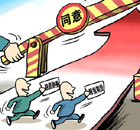Central bank raises 0.5% reserve deposit ratio
(Xinhua)
Updated: 2010-02-13 09:39
 |
Large Medium Small |
BEIJING - The People's Bank of China (PBOC), the country's central bank, announced Friday it will raise the deposit reserve requirement ratio (RRR) for Chinese financial institutions by 0.5 percentage points from February 25 this year.
The ratio would not change for small financial institutions, such as the rural credit cooperatives, as the PBOC wants to support the "sannong" - farmers, rural areas, and agriculture - and the county-level economy.
| ||||
The move targets the "comparatively loose liquidity" while keeping the "moderately easy" monetary policy unchanged, an unnamed PBOC spokesman said.
With the adjustment, the RRR for Chinese large financial institutions rises to 16.5 percent, while the RRR for small financial institutions remains unchanged at 13.5 percent.
The rise is the second for the deposit ratio this year. The deposit ratio was last raised on January 18, 2010. The central bank had held the deposit ratio steady since it last cut it in December 2008.
"The increase in the deposit ratio is within expectations and it is a normal move for a central bank to manage liquidity," said Liu Yuhui, economist with the Chinese Academy of Social Sciences, a government think tank.
A moderate withdrawal of liquidity will help ease inflationary pressures, Liu added.
The country's January consumer price index (CPI), the main gauge of inflation, increased 1.5 percent from a year earlier.
Although the January CPI was lower than market expectations, that was because of the high comparison base of January 2009, the month the lunar New Year fell, Liu said.
The index is likely to hit 2.5 percent in February, as the Lunar New Year holiday falls between February 13 and 19 this year, he added.
The 0.5-percentage-point increase in the deposit ratio will help freeze 300 billion yuan (43.9 billion U.S. dollars) in liquidity, said Li Huaiding, an analyst with Guosen Securities.
The central bank said in its quarterly report Thursday the country will continue to keep a moderately easy monetary policy but would enhance the focus and flexibility of policy according to new conditions.
The PBOC said it would work to balance stable and comparatively fast economic growth with the adjustments in the nation's economic structure, while managing inflation pressures.
The PBOC cut the bank reserve requirement ratio four times during the second half of 2008 to stimulate growth, as the global financial crisis weighed on the economy.
China announced on November 5, 2008 a shift in monetary policy from "tight" to "moderately loose", to help the national economy ride out the global slowdown.
Thanks to the 4-trillion-yuan economic stimulus package, the proactive fiscal policy and moderately easy monetary policy, China's economy grew 10.7 percent year-on-year in the fourth quarter of 2009, accelerating from 9.1 percent in the third quarter, 7.9 percent in the second quarter and 6.2 percent in the first quarter.
New yuan-denominated loans in 2009 totaled 9.6 trillion yuan, nearly double the 2008 figure of 4.9 trillion yuan.










